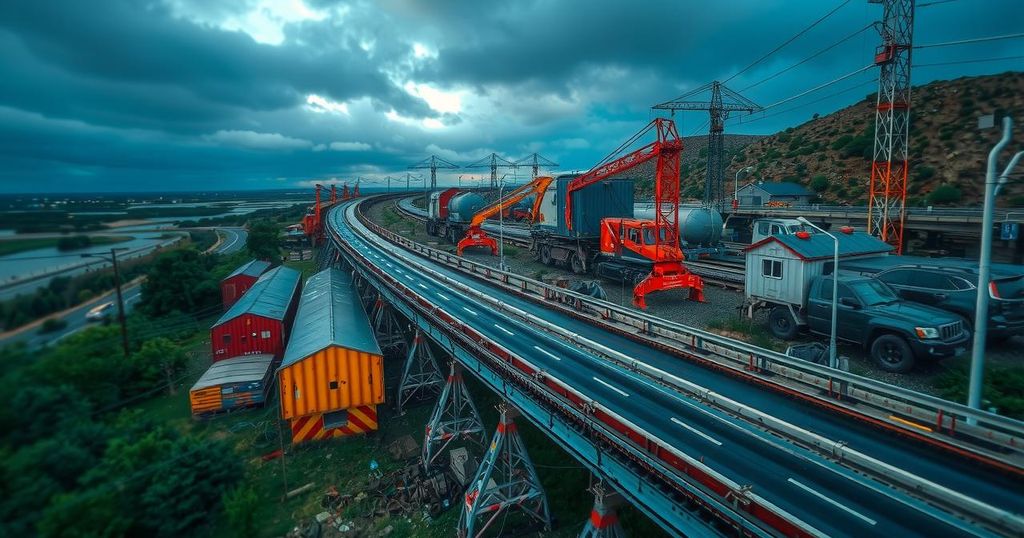Researchers from the University of Virginia have identified that climate change significantly threatens infrastructure, particularly roads and bridges, as extreme weather events become more common. Their study indicates that smaller watersheds are more vulnerable to increased peak streamflow due to less land for water absorption, necessitating revised engineering designs to accommodate projected rainfall intensities that could rise 10% to 40% by 2085. The findings emphasize the importance of proactive planning and adaptation in infrastructure management.
Climate change poses a significant threat to critical infrastructure across the United States, particularly roads and bridges designed to withstand historically average rainfall levels. As severe weather events, including heavy rainfall, become increasingly common, existing systems may struggle to cope effectively. Researchers from the University of Virginia have conducted a comprehensive study to assess the potential impact of climate change on rainfall patterns and, in turn, the implications for infrastructure and water management systems. Utilizing advanced computer modeling techniques, the team aims to equip engineers with essential tools to adapt current designs to these evolving conditions. The research particularly emphasizes the vulnerability of smaller watersheds to climate-induced variances in precipitation and streamflow. Specifically, the study examines the differing effects on the Rivanna River watershed, which spans approximately 750 square miles, compared to the significantly smaller Moore’s Creek watershed of 35 square miles. The findings suggest a pronounced escalation in peak streamflow for smaller watersheds due to their limited capacity to absorb rainfall, thereby leading to more rapid runoff into streams. The team, led by Mohamed M. Morsy, a former Ph.D. student of Professor Jonathan Goodall, published their results in the Journal of Hydrologic Engineering, highlighting critical insights into how infrastructure must evolve in response to climate predictions. For instance, their models indicate that rainfall intensity could increase by 10% to 40% by the year 2085, urging engineers to revise their calculations for hydraulic structures like bridges and culverts accordingly. The study underlines the increasing need for forward-thinking in infrastructure planning amid escalating climate risks. Advanced mathematical regression equations have been developed to help predict peak streamflow based on watershed characteristics and climate projections. Such tools are intended to assist policymakers and decision-makers in prioritizing necessary infrastructure improvements to mitigate potential flooding risks, especially in vulnerable coastal regions.
The impact of climate change on infrastructure represents a growing concern for engineers and policymakers. Historically, infrastructure systems in the United States have been designed based on stable rainfall averages; however, as climate change leads to more extreme weather patterns, these systems’ effectiveness is being challenged. The necessity for adaptation in civil engineering is increasingly recognized, particularly in light of findings that smaller watersheds exhibit greater vulnerability to enhanced rainfall and associated flooding. This shift in understanding demands that engineering solutions evolve in response to projected climate scenarios, enhancing the resilience of vital infrastructure. The research focused on Virginia’s Coastal Plain, wherein a detailed analysis of watershed responsiveness to climate variability was conducted using sophisticated modeling approaches to simulate future flooding conditions. The implications of increased rainfall intensity are severe, necessitating proactive planning and design re-evaluations across numerous jurisdictions as climate change continues to influence hydrological cycles.
The research conducted by the University of Virginia signifies an urgent call to action for the engineering community in light of climate change’s anticipated effects on infrastructure. With empirical data indicating significant increases in rainfall intensity, particularly within smaller watersheds, engineers must adapt their strategies to enhance resilience against flooding. Such measures are no longer optional, but imperative for maintaining the integrity and safety of infrastructure systems in the face of evolving climate realities.
Original Source: engineering.virginia.edu






